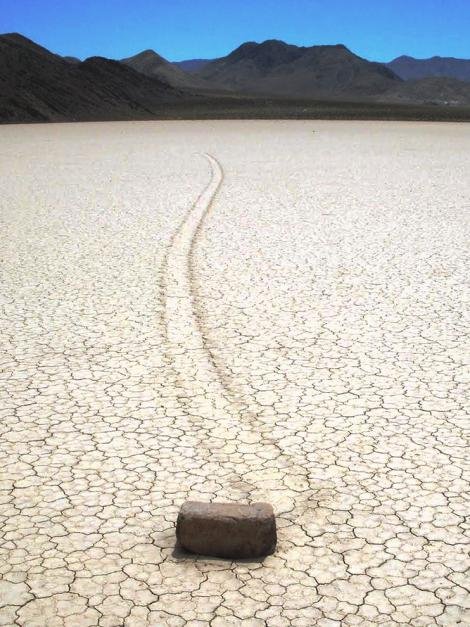Did you know that there are stones that move on their own, that can reach the normal rhythm of a person when walking and that the traces left by crawling can be maintained for years?

📷 Shot by Guillermo Bustamante.
Is seriously! there are rocks capable of mobilizing by themselves. It is a geological phenomenon produced by the combination of rain, ice, sun, wind and mud; that for years had intrigued the world.
The first records of "sliding stones" were made around 1940 in the dry lake "Racetrack Playa", in the Valley of Death, in California; where we found stones, up to the size of a person, that seemed to have been dragged hundreds of meters; Some traces indicate that the rocks moved in pairs, and there were even cases in which there was some point where took another direction or was returned.
They presented many hypotheses about the process, both supernatural explanations and complex scientific assumptions; but nobody had witnessed such a "miracle" until 2013, when researchers Richard Norris and James Norris, after two years of continuous studies, managed to visualize it. The funny thing is that they didn't expect to coincide so soon with the phenomenon, because the stones can last up to a decade without moving.

📷 Shot by Cynthya Cheung for National Geographic.
In 2011, to register the process, the Norris cousins installed in 15 rocks customized and activated GPS units with movement, as well as a meteorological station to monitor them. It should be noted that the stones used for the study were external, because that the National Park Service did not allow the use of native rocks.
The final work, which was published in the PLOS ONE magazine in August 2014, concluded "that moving the rocks requires a rare combination of events. First, the playa fills with water, which must be deep enough to form floating ice during cold winter nights but shallow enough to expose the rocks. As nighttime temperatures plummet, the pond freezes to form thin sheets of “windowpane” ice, which must be thin enough to move freely but thick enough to maintain strength. On sunny days, the ice begins to melt and break up into large floating panels, which light winds drive across the playa, pushing rocks in front of them and leaving trails in the soft mud below the surface".

📷 Shot by Maggie Mcadam para National Geographic.
Thanks to the research of Richard D. Norris, James M. Norris with the participation of Ralph D. Lorenz, Jib Ray and Brian Jacksone, it is considered that the mystery was solved.
Racetrack Playa is not the only place where this phenomenon occurs, activity has also been recorded in other parts of the United States, in the Tunisian Sahara, in South Africa and in Spain.
Analogy 💡
When I started writing this post I did it with the intention of only sharing the concept of main photography, but the subject is so interesting that it would be very inconsiderate if it did not allow them to fascinate in the same way with him.
As for the photo, my father takes it, Guillermo Bustamante, while I began my trip in Paddleboard. I was surprised to see the composition, and even more to know that I had taken it by chance, without wearing magnifying glasses. When I noticed that my figure was coincidentally aligned with the stones, which were also aligned with each other, I instantly remembered "The mystery of the rocks that sail".
I related the photo to the story and saw a perfect representation of what my personality is like: strong as a rock, but mobile as the wind; someone who leaves traces where he travels. In addition, I love the sea and seeing myself in the water next to the other elements of the photo amused me and I concluded that "I am like a sea navigator stone!" 💙
🔎 Sources:
strange reality
Strange, but fascinating 😄
In this life these things that we do not understand maybe reveal to us that we did not understand anything at all!